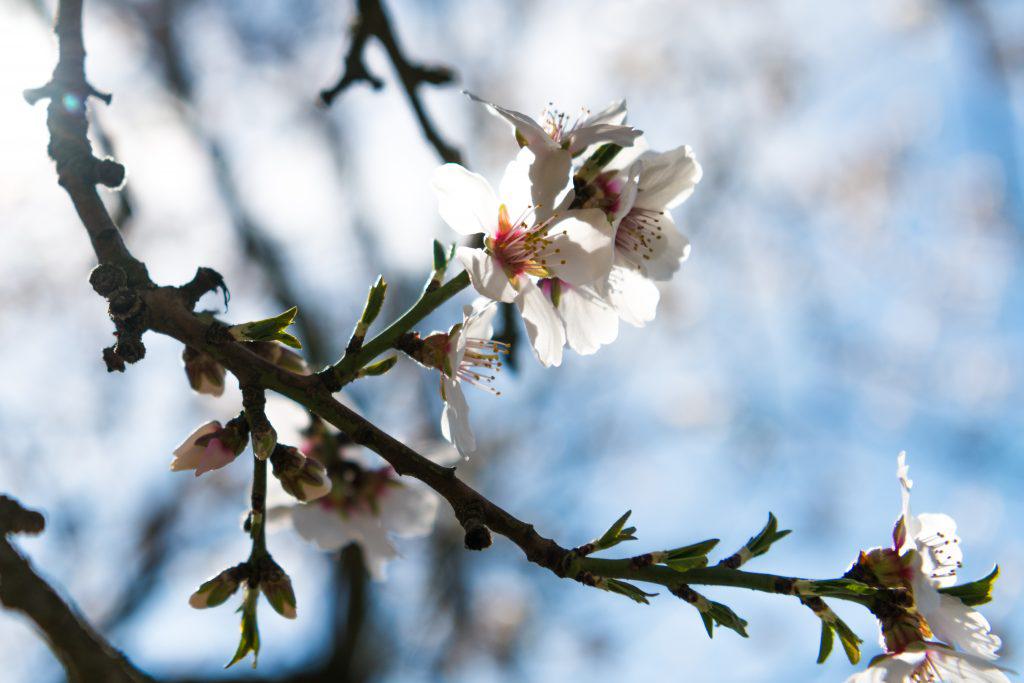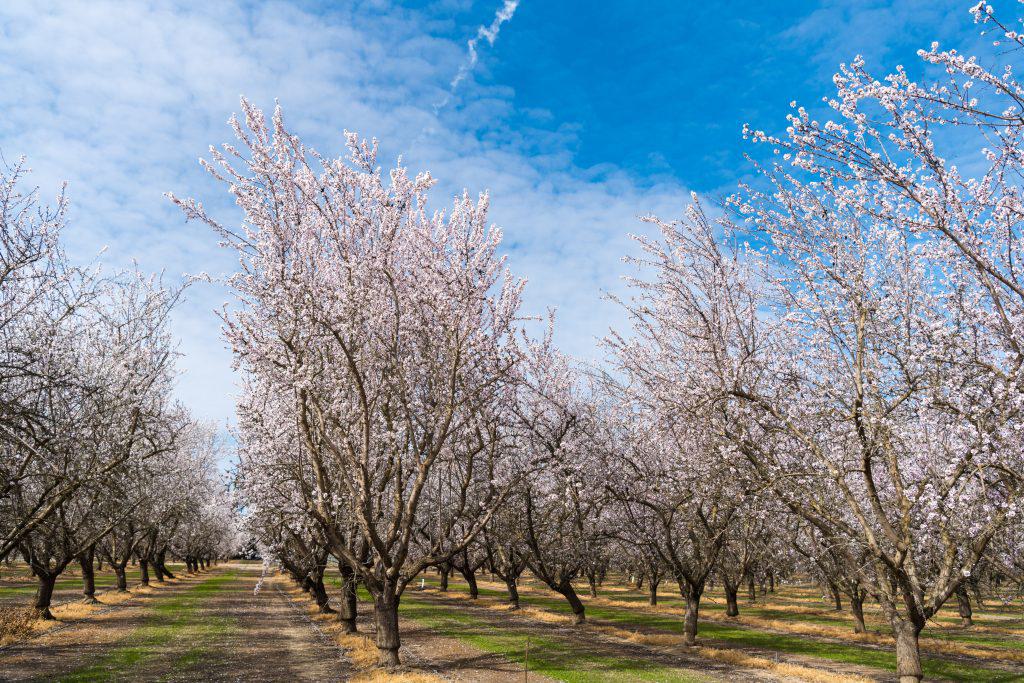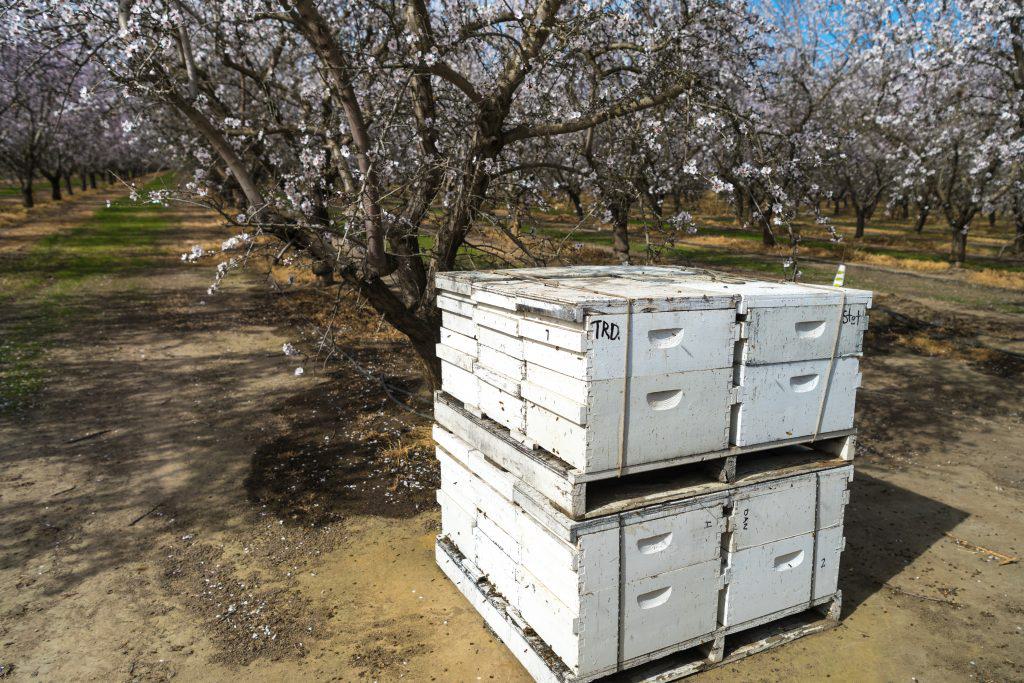[caption id="attachment_1164898" align="alignright" width="500"]

Up close and personal with almond blossoms during a recent visit to an orchard. Photo credit: Julie Garner[/caption]
Almonds are among the United States' most popular nuts: according to the US Department of Agriculture, the average American ate 1.8 pounds (about 662 nuts!) in 2016 alone. The reasons are obvious--in addition to being packed full of fiber, healthy fats, and plant-based protein, almonds are portable and delicious, whether they're stirred into a bowl of oatmeal or eaten by the handful as a snack. Here at Bob's Red Mill, almonds are the star of our
Almond Flour and
Super Fine Natural Almond Flour, and they play an important supporting role in our
Mueslis and, of course, our
Honey Almond Granola. But where do our almonds come from? How are they grown? And how healthy are they, really?
A Brief History of Almonds
Originating in ancient times in the fertile soil of the Mediterranean (they were mentioned in the Bible as early as 1400 BC), almonds were soon prized for their nutrition, convenience, and flavor. They were carried by explorers travelling to China via the Silk Road, and in the 1700s, they were brought to California by Franciscan priests. Little did they know that by the 20th century, California almonds would be the state's largest agricultural export. Today, almond trees cover 1.24
million acres in California's Central Valley and supply more than 80% of the world's almonds. All of the almonds here at Bob's Red Mill make the short trip from these California orchards to our mill in Milwaukie, Oregon!
Life Cycle of an Almond
[caption id="attachment_1165185" align="alignleft" width="500"]

Almond orchard in bloom! Photo credit: Julie Garner[/caption]
The average lifespan of an almond tree is 20 to 25 years, and a healthy tree can produce between 50 and 65 pounds each year. They thrive in climates that provide hot, dry summers and cool winters, which is why California has had such phenomenal success growing almond trees. But how do they grow? After lying dormant over the winter, the trees burst into bloom in early spring, ready for pollination. We recently visited one of our almond suppliers and were able to walk through an orchard full of almonds in bloom (the source of the beautiful photos in this post), and it was an incredibly gorgeous sight!
After pollination (more on that below), the almond grows inside a fuzzy green hull from March until June. They look a little like green apricots, which makes sense, because almonds are actually stone fruits and members of the rose family, which also includes plums and peaches. In the summer, the hull breaks open, allowing the shell to dry and harden. Then it's time to shake it up! From mid-August through October, mechanical tree shakers roll through the orchards, literally shaking the nuts onto the ground, where they continue to dry for a week or more before they're swept up, separated from their hulls and shells, and sized. Whew!
Bees and Almonds: Friends with Benefits?
[caption id="attachment_1165181" align="alignright" width="500"]

Pollination station! A bee hive visits an almond orchard in early spring.Photo credit: Julie Garner[/caption]
Honey bee health has been a big concern in recent decades, and for good reason. According to the Food and Agricultural Organization of the United Nations, 33% of our global food production relies on pollinators. Almond plants need pollination in order to produce nuts, so millions of bees are brought to orchards each year. In many ways, this is mutually beneficial: almond pollen is nutritious for the bees, and as it is typically their first natural food source of the season, it can set them up for a healthy year. However, concerns about pesticides and fungicides are still present--when used together, they can sometimes create unintended ill effects.Because no bees = no almonds, theAlmond Board of California has invested heavily in honey bee health, funding more than 100 research projects in the past 20 years.
Almonds, Water, and Waste
[caption id="attachment_1165187" align="alignleft" width="500"]

Modern drip irrigation has helped almond farmers reduce water. Photo credit: Julie Garner[/caption]
Another concern about almonds, especially in drought-prone California, is the amount of water used per acre. Unlike many crops, almond trees require watering year round. In response to this issue, farmers have worked hard to reduce the amount of water needed to grow one pound of almonds by 33% in the past 20 years (according to the Almond Board of California), mainly by utilizing new drip-irrigation methods and recharging groundwater aquifers--effectively recapturing water used for crops for reuse. And as the
LA Times reports, while the number of almond trees has increased by 60%, water consumption has remained at the same level. Another factor to consider is that almond crops don't just produce nuts: the hulls are sold as livestock feed, while the shells provide bedding for animals, resulting in less waste.
Benefits of Almonds
[caption id="attachment_1164900" align="alignright" width="400"]

A tempting citrus cake made with Bob's Red Mill Almond Flour!Photo credit: Julie Garner[/caption]
Nutrient-rich almonds have many benefits: a one-ounce serving--about 23 nuts--contains approximately 164 calories, 14 grams of fat (mainly of the heart-healthy monounsaturated variety), 6 grams of protein, and 3.4 grams of fiber. They also contain calcium and great nutrients like vitamin E, manganese, and magnesium. Because they're a low glycemic index food, almonds can help control blood sugar and maintain weight loss. The only problem? Almonds are so delicious, you may have trouble with portion control!
Popular Uses for Almonds
Beyond snacking, almonds have become ever-more popular in gluten free, paleo, and keto recipes, as well as low-carb baking:
Bob's Red Mill's Almond Flour is one of our top-selling products, and our customers use
almond flour in recipes for cakes, cookies, muffins, pancakes, and more. Almonds also provide crunch for our
Muesli and
Honey Almond Granola, and we--of course--love to sprinkle them on our morning oatmeal.
How do
youlike to eat almonds? Do you have a favorite almond recipe? Tell us in the comments!



 Up close and personal with almond blossoms during a recent visit to an orchard. Photo credit: Julie Garner[/caption]
Almonds are among the United States' most popular nuts: according to the US Department of Agriculture, the average American ate 1.8 pounds (about 662 nuts!) in 2016 alone. The reasons are obvious--in addition to being packed full of fiber, healthy fats, and plant-based protein, almonds are portable and delicious, whether they're stirred into a bowl of oatmeal or eaten by the handful as a snack. Here at Bob's Red Mill, almonds are the star of our Almond Flour and Super Fine Natural Almond Flour, and they play an important supporting role in our Mueslis and, of course, our Honey Almond Granola. But where do our almonds come from? How are they grown? And how healthy are they, really?
Up close and personal with almond blossoms during a recent visit to an orchard. Photo credit: Julie Garner[/caption]
Almonds are among the United States' most popular nuts: according to the US Department of Agriculture, the average American ate 1.8 pounds (about 662 nuts!) in 2016 alone. The reasons are obvious--in addition to being packed full of fiber, healthy fats, and plant-based protein, almonds are portable and delicious, whether they're stirred into a bowl of oatmeal or eaten by the handful as a snack. Here at Bob's Red Mill, almonds are the star of our Almond Flour and Super Fine Natural Almond Flour, and they play an important supporting role in our Mueslis and, of course, our Honey Almond Granola. But where do our almonds come from? How are they grown? And how healthy are they, really?
 Almond orchard in bloom! Photo credit: Julie Garner[/caption]
The average lifespan of an almond tree is 20 to 25 years, and a healthy tree can produce between 50 and 65 pounds each year. They thrive in climates that provide hot, dry summers and cool winters, which is why California has had such phenomenal success growing almond trees. But how do they grow? After lying dormant over the winter, the trees burst into bloom in early spring, ready for pollination. We recently visited one of our almond suppliers and were able to walk through an orchard full of almonds in bloom (the source of the beautiful photos in this post), and it was an incredibly gorgeous sight!
After pollination (more on that below), the almond grows inside a fuzzy green hull from March until June. They look a little like green apricots, which makes sense, because almonds are actually stone fruits and members of the rose family, which also includes plums and peaches. In the summer, the hull breaks open, allowing the shell to dry and harden. Then it's time to shake it up! From mid-August through October, mechanical tree shakers roll through the orchards, literally shaking the nuts onto the ground, where they continue to dry for a week or more before they're swept up, separated from their hulls and shells, and sized. Whew!
Almond orchard in bloom! Photo credit: Julie Garner[/caption]
The average lifespan of an almond tree is 20 to 25 years, and a healthy tree can produce between 50 and 65 pounds each year. They thrive in climates that provide hot, dry summers and cool winters, which is why California has had such phenomenal success growing almond trees. But how do they grow? After lying dormant over the winter, the trees burst into bloom in early spring, ready for pollination. We recently visited one of our almond suppliers and were able to walk through an orchard full of almonds in bloom (the source of the beautiful photos in this post), and it was an incredibly gorgeous sight!
After pollination (more on that below), the almond grows inside a fuzzy green hull from March until June. They look a little like green apricots, which makes sense, because almonds are actually stone fruits and members of the rose family, which also includes plums and peaches. In the summer, the hull breaks open, allowing the shell to dry and harden. Then it's time to shake it up! From mid-August through October, mechanical tree shakers roll through the orchards, literally shaking the nuts onto the ground, where they continue to dry for a week or more before they're swept up, separated from their hulls and shells, and sized. Whew!
 Pollination station! A bee hive visits an almond orchard in early spring.Photo credit: Julie Garner[/caption]
Honey bee health has been a big concern in recent decades, and for good reason. According to the Food and Agricultural Organization of the United Nations, 33% of our global food production relies on pollinators. Almond plants need pollination in order to produce nuts, so millions of bees are brought to orchards each year. In many ways, this is mutually beneficial: almond pollen is nutritious for the bees, and as it is typically their first natural food source of the season, it can set them up for a healthy year. However, concerns about pesticides and fungicides are still present--when used together, they can sometimes create unintended ill effects.Because no bees = no almonds, theAlmond Board of California has invested heavily in honey bee health, funding more than 100 research projects in the past 20 years.
Pollination station! A bee hive visits an almond orchard in early spring.Photo credit: Julie Garner[/caption]
Honey bee health has been a big concern in recent decades, and for good reason. According to the Food and Agricultural Organization of the United Nations, 33% of our global food production relies on pollinators. Almond plants need pollination in order to produce nuts, so millions of bees are brought to orchards each year. In many ways, this is mutually beneficial: almond pollen is nutritious for the bees, and as it is typically their first natural food source of the season, it can set them up for a healthy year. However, concerns about pesticides and fungicides are still present--when used together, they can sometimes create unintended ill effects.Because no bees = no almonds, theAlmond Board of California has invested heavily in honey bee health, funding more than 100 research projects in the past 20 years.
 Modern drip irrigation has helped almond farmers reduce water. Photo credit: Julie Garner[/caption]
Another concern about almonds, especially in drought-prone California, is the amount of water used per acre. Unlike many crops, almond trees require watering year round. In response to this issue, farmers have worked hard to reduce the amount of water needed to grow one pound of almonds by 33% in the past 20 years (according to the Almond Board of California), mainly by utilizing new drip-irrigation methods and recharging groundwater aquifers--effectively recapturing water used for crops for reuse. And as theLA Times reports, while the number of almond trees has increased by 60%, water consumption has remained at the same level. Another factor to consider is that almond crops don't just produce nuts: the hulls are sold as livestock feed, while the shells provide bedding for animals, resulting in less waste.
Modern drip irrigation has helped almond farmers reduce water. Photo credit: Julie Garner[/caption]
Another concern about almonds, especially in drought-prone California, is the amount of water used per acre. Unlike many crops, almond trees require watering year round. In response to this issue, farmers have worked hard to reduce the amount of water needed to grow one pound of almonds by 33% in the past 20 years (according to the Almond Board of California), mainly by utilizing new drip-irrigation methods and recharging groundwater aquifers--effectively recapturing water used for crops for reuse. And as theLA Times reports, while the number of almond trees has increased by 60%, water consumption has remained at the same level. Another factor to consider is that almond crops don't just produce nuts: the hulls are sold as livestock feed, while the shells provide bedding for animals, resulting in less waste.
 A tempting citrus cake made with Bob's Red Mill Almond Flour!Photo credit: Julie Garner[/caption]
Nutrient-rich almonds have many benefits: a one-ounce serving--about 23 nuts--contains approximately 164 calories, 14 grams of fat (mainly of the heart-healthy monounsaturated variety), 6 grams of protein, and 3.4 grams of fiber. They also contain calcium and great nutrients like vitamin E, manganese, and magnesium. Because they're a low glycemic index food, almonds can help control blood sugar and maintain weight loss. The only problem? Almonds are so delicious, you may have trouble with portion control!
A tempting citrus cake made with Bob's Red Mill Almond Flour!Photo credit: Julie Garner[/caption]
Nutrient-rich almonds have many benefits: a one-ounce serving--about 23 nuts--contains approximately 164 calories, 14 grams of fat (mainly of the heart-healthy monounsaturated variety), 6 grams of protein, and 3.4 grams of fiber. They also contain calcium and great nutrients like vitamin E, manganese, and magnesium. Because they're a low glycemic index food, almonds can help control blood sugar and maintain weight loss. The only problem? Almonds are so delicious, you may have trouble with portion control!